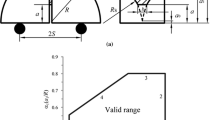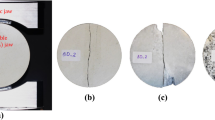Abstract
The International Society for Rock Mechanics has so far developed two standard methods for the determination of static fracture toughness of rock. They used three different core-based specimens and tests were to be performed on a typical laboratory compression or tension load frame. Another method to determine the mode I fracture toughness of rock using semi-circular bend specimen is herein presented. The specimen is semi-circular in shape and made from typical cores taken from the rock with any relative material directions noted. The specimens are tested in three-point bending using a laboratory compression test instrument. The failure load along with its dimensions is used to determine the fracture toughness. Most sedimentary rocks which are layered in structure may exhibit fracture properties that depend on the orientation and therefore measurements in more than one material direction may be necessary. The fracture toughness measurements are expected to yield a size-independent material property if certain minimum specimen size requirements are satisfied.





Similar content being viewed by others
References
Abaqus Unified FEA (2012) Dassault systems
Aliha MRM, Sistaninia M, Smith DJ, Pavier MJ, Ayatollahi MR (2012) Geometry effects and statistical analysis of mode I fracture in Guiting limestone. Int J Rock Mech Min Sci 51:128–135
Ayatollahi MR, Aliha MRM (2007) Wide range data for crack tip parameters in two disc-type specimens under mixed mode loading. Comput Mater Sci 38:660–670
Backers T, Stephansson O (2012) ISRM suggested method for the determination of mode II fracture toughness. Rock Mech Rock Engng 45:1011–1022
Basham KD (1989) Nonlinear fracture mechanics using semi-circular specimens and tension softening behaviour. PhD dissertation, Department of Civil Engineering, The University of Wyoming, USA
Bazant ZP (1984) Size effect in blunt fracture: concrete, rock, metal. J Engng Mech Div ASCE 110:518–535
Chong KP, Kuruppu MD (1984) New specimen for fracture toughness determination of rock and other materials. Int J Fract 26:R59–R62
Chong KP, Kuruppu MD, Kuszmaul JS (1987) Fracture toughness determination of layered materials. Eng Fract Mech 28:43–54
Funatsu T, Seto M, Shimada H, Matsui K, Kuruppu M (2004) Combined effects of increasing temperature and pressure on the fracture toughness of clay bearing rocks. Int J Rock Mech Min Sci 41:927–938
ISRM (2007) The complete ISRM suggested methods for rock characterization, testing and monitoring: 1974–2006. In: Ulusay R, Hudson JA (eds) Suggested methods prepared by the commission on testing methods, International Society for Rock Mechanics, compilation arranged by the ISRM Turkish National Group. Kozan Ofset, Ankara
Karfakis MG, Akram M (1993) Effects of chemical solutions on rock fracturing. Int J Rock Mech Min Sci Geomech Abstr 30(7):1253–1259
Kataoka M, Obara Y, Yoshinaga T, Kuruppu M (2010) Fracture toughness of rock under water vapour pressure. In: Proceedings of the ISRM International Symposium on Rock Mechanics and 6th Asian Rock Mechanics Symposium, New Delhi, Paper No. 12 (on CD)
Kataoka M, Obara Y, Kuruppu M (2011) Estimation of fracture toughness of anisotropic rocks by SCB test and visualization of fracture by means of X-ray CT. In: Qian Q, Zhou Y (eds) Proceedings of the ISRM 12th International Congress on Rock Mechanics, Beijing, pp 667–670
Khan K, Al-Shayea NA (2000) Effect of specimen geometry and testing method on mixed mode I–II fracture toughness of a limestone rock from Saudi Arabia. Rock Mech Rock Engng 33(3):179–206
Kuruppu MD, Chong KP (2012) Fracture toughness testing of brittle materials using semi-circular bend (SCB) specimen. Eng Fract Mech 91:133–150
Kuruppu MD, Seto M (2001) Determination of fracture toughness of rock under in situ conditions using semi-circular specimen. In: Proceedings of ICF10, 10th International Conference on Fracture, Hawaii, pp 651 (abstracts vol)
Lim IL, Johnston IW, Choi SK (1993) Stress intensity factors for semi-circular specimens under three-point bending. Eng Fract Mech 44(3):363–382
Lim IL, Johnston IW, Choi SK, Boland JN (1994) Fracture testing of a soft rock with semi-circular specimens under three-point loading, part 1-mode I. Int J Rock Mech Min Sci 31:185–197
Liu HW (1983) On the fundamental basis of fracture mechanics. Eng Fract Mech 17:425–438
Molenar AAA, Scarpas A, Liu X, Erkens SMJG (2002) Semi-circular bending test; simple but useful? J Assoc Asph Paving Technol 71:794–815
Obara Y, Sasaki K, Matusyama T, Yoshinaga T (2006) Influence of water vapour pressure of surrounding environment on fracture toughness of rock. In: Proceedings of ARMS 2006, Asian Rock Mechanics Symposium, Singapore, 7th chapter (on CD)
Obara Y, Sasaki K, Yoshinaga T (2007a) Estimation of fracture toughness of rocks under water vapour pressure by semi-circular bend (SCB) test. J of MMIJ 123:145–151
Obara Y, Sasaki K, Yoshinaga T (2007b) Influence of water vapour pressure of surrounding environment on fracture toughness and crack velocity of rocks. In: Proceedings of 11th congress of ISRM, Vol 1. Lisbon, pp 51-54
Obara Y, Yoshinaga T, Hirata A (2009) Fracture toughness in mode I and II of rock under water vapour pressure. In: Vrkljan I (ed) Proceedings of ISRM regional symposium EUROCK, Cavtat, pp 333–338
Obara Y, Kuruppu M, Kataoka M (2010) Determination of fracture toughness of anisotropic rocks under water vapour pressure by semi-circular bend test. In: Topal E, Kuruppu MD (eds) Proceedings of mine planning and equipment selection, The Australasian Institute of Mining and Metallurgy, Victoria, Australia, pp 599–610
Ouchterlony F (1989) Fracture toughness testing of rock with core based specimens, the development of an ISRM standard. In: Mihashi H, Takahashi H (eds) Fracture toughness and fracture energy. A. A. Balkema, Rotterdam, The Netherlands, pp 231–251
Ouchterlony F (1990) Fracture toughness testing of rock with core based specimens. Eng Fract Mech 35:351–366
Tutluoglu L, Keles C (2011) Mode I fracture toughness determination with straight notched disk bending method. Int J Rock Mech Min Sci 48:1248–1261
Whittaker BN, Singh RN, Sun G (1992) Rock fracture mechanics—principles, design and applications. Elsevier Sci Publisher, Amsterdam
Zhou YX, Xia K, Li XB, Li HB, Ma GW, Zhao J, Zhou ZL, Dai F (2012) Suggested methods for determining the dynamic strength parameters and mode-I fracture toughness of rock materials. Int J Rock Mech Min Sci 49:105–112
Acknowledgments
The authors thankfully acknowledge the guidance and encouragement given by Prof. Resat Ulusay, President of the ISRM commission on testing methods, and other commission members in order to develop this suggested method.
Author information
Authors and Affiliations
Corresponding author
Appendix: Details of Numerical Analysis Used for Deriving Eq. (2)
Appendix: Details of Numerical Analysis Used for Deriving Eq. (2)
The SCB specimens of different crack lengths were simulated and analyzed using eight-node plane-strain elements in the finite element code Abaqus Unified FEA (2012). The loading, the boundary conditions and a typical finite element mesh used for the simulations are shown in Fig. 6. Singular elements with nodes at quarter-point positions were used for the first ring of elements around the crack tip. In the circular partitions surrounding the crack tip where the contour integrals are calculated, the mesh was biased toward the crack tip. The stress intensity factors K I were extracted directly from ABAQUS which makes use of the J-integral method to compute the stress intensity factors. The numerical results showed that there was negligible variation in the J-integral values calculated for successive contours surrounding the crack tip.
Using a fixed arbitrary load P, the stress intensity factor K I was determined for each set of β and \( \frac{s}{2R} \), and the non-dimensional stress intensity factor \( Y^{'} \) was calculated from
then Eq. (2) was derived by fitting a second order polynomial to the numerical results obtained for \( Y^{'} \). Tutluoglu and Keles (2011) recently reported limited numerical results for \( Y^{'} \) in the SCB specimen. As shown in Table 3, very good agreement exists between the present results and those reported by Tutluoglu and Keles (2011). Table 3 can also be considered as validation for the finite element results obtained in this study, particularly for the ranges 0.4 ≤ β ≤ 0.6 and 0.5 ≤ s/2R ≤ 0.8, as suggested in Sect. 6.
It is noteworthy that a number of investigators have presented mode I stress intensity factors of the SCB specimen (Chong et al. 1987; Lim et al. 1994; Basham 1989). For instance, Lim et al. (1994) extracted the stress intensity factors of the SCB specimen from finite element analysis and suggested a fifth order polynomial for \( Y^{'} \) as.
Figure 7 shows a comparison between the curves plotted based on Eqs. (2) and (A2) for different values of β and \( \frac{s}{2R} \). Significant discrepancies can be seen between these two sets of results.
Having checked our finite element results by different mesh designs and element numbers, we concluded that the observed discrepancy can be due to less accurate method used by Lim et al. (1994) for determining the stress intensity factors of the SCB specimen. The displacement/stress extrapolation method employed by Lim et al. was a common technique in the 1990s for deriving stress intensity factors from finite element results. But, later more accurate methods were proposed like the contour integral techniques (e.g. J-integral method). It is now well established that the numerical errors in the region of high stress gradient around the crack tip affects the J-integral method much less than the displacement/stress extrapolation technique.
Rights and permissions
About this article
Cite this article
Kuruppu, M.D., Obara, Y., Ayatollahi, M.R. et al. ISRM-Suggested Method for Determining the Mode I Static Fracture Toughness Using Semi-Circular Bend Specimen. Rock Mech Rock Eng 47, 267–274 (2014). https://doi.org/10.1007/s00603-013-0422-7
Received:
Accepted:
Published:
Issue Date:
DOI: https://doi.org/10.1007/s00603-013-0422-7






